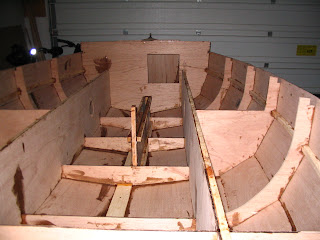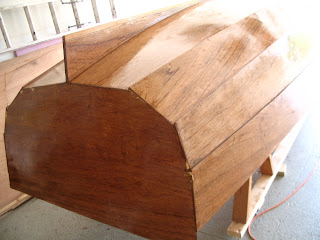In the past four weeks I worked on the plans for spars and sails, but I also took advantage of the few and rare mild and dry days to work on building and finishing the control surfaces (rudder, tiller and centerboard—CB). I call them control surfaces, even though I don't know if anyone else does, because of the aviation analogy: that's what rudder, ailerons, elevons, etc. are called in planes, and I used to build model planes years ago (as if more evidence of being a nerd and an "anorak" were needed).
Anyway, I designed and cut the tiller, which is made of cedar sandwiched between two layers of 6mm (1/4 inch) plywood. The plywood extends beyond the cedar core to create the jaws that will enclose the top of the rudder, and the jaws themselves are reinforced with a layer of 9mm (3/8 inch) plywood on each side. You can see the nice, curved shape that I cut: it brings the tip of the tiller down from the high transom top to a comfortable hand position, but high enough to clear the boat’s sides if necessary. I will find out if I need a tiller extension after the launch. And BTW, if you look carefully at the rudder you'll see a couple of holes drilled in error (pathetic, I know, but easily fixed with filleting compound).
Anyway, I designed and cut the tiller, which is made of cedar sandwiched between two layers of 6mm (1/4 inch) plywood. The plywood extends beyond the cedar core to create the jaws that will enclose the top of the rudder, and the jaws themselves are reinforced with a layer of 9mm (3/8 inch) plywood on each side. You can see the nice, curved shape that I cut: it brings the tip of the tiller down from the high transom top to a comfortable hand position, but high enough to clear the boat’s sides if necessary. I will find out if I need a tiller extension after the launch. And BTW, if you look carefully at the rudder you'll see a couple of holes drilled in error (pathetic, I know, but easily fixed with filleting compound).
I also glued together the two layers that make up the rudder top and bottom and the centerboard. Finally I did a lot of sanding on all the pieces, including putting rounded leading edges and tapered trailing edges on the CB (last photo) and rudder bottom, to reduce the drag they create as they flow through the water.
 Then, as planned, I moved most of the tools and materials into the basement—the garage has got too cold for epoxy to cure, not to mention uncomfortable for the person doing the work. The basement has no real ventilation in the winter (too cold to open the windows) and it lies under the dining room and kitchen of the house, so I have to be careful about fumes and dust. I duct-taped a furnace filter to a box fan, which takes care of most of the dust, and I do whatever epoxy work I need in small batches with a respirator on and the fan at full blast. So far things have worked out OK, and I will leave the coating of the spar surfaces until the spring. Anyway, I am pleased to say that I am basically done with the rudder, tiller and centerboard. They have been sanded and given two coats of epoxy; the rudder jaws were nailed and glued on, and the pivoting and fixed parts of the rudder drilled and bolted together. The fit is pretty tight and some extra sanding was necessary: I will need to use some waterproof lubricant to make the pivoting smoother. The tiller will be connected to the rudder top with a bolt (a clevis pin is standing in for now) that allows the tiller to pivot up when needed, and pintles and gudgeons were bolted and screwed in place.
Then, as planned, I moved most of the tools and materials into the basement—the garage has got too cold for epoxy to cure, not to mention uncomfortable for the person doing the work. The basement has no real ventilation in the winter (too cold to open the windows) and it lies under the dining room and kitchen of the house, so I have to be careful about fumes and dust. I duct-taped a furnace filter to a box fan, which takes care of most of the dust, and I do whatever epoxy work I need in small batches with a respirator on and the fan at full blast. So far things have worked out OK, and I will leave the coating of the spar surfaces until the spring. Anyway, I am pleased to say that I am basically done with the rudder, tiller and centerboard. They have been sanded and given two coats of epoxy; the rudder jaws were nailed and glued on, and the pivoting and fixed parts of the rudder drilled and bolted together. The fit is pretty tight and some extra sanding was necessary: I will need to use some waterproof lubricant to make the pivoting smoother. The tiller will be connected to the rudder top with a bolt (a clevis pin is standing in for now) that allows the tiller to pivot up when needed, and pintles and gudgeons were bolted and screwed in place. So the rudder is almost ready to use. In the spring I will give it a couple of coats of spar varnish as well. At that time I will attach the centerboard to its case with another bolt so it can pivot into the water—this will need to happen before I fill the ballast box with lead and lay down the floorboards. Both rudder and CB will need bungee cords to keep them in the down position and cleated lines to pull them up.
Next I will be laminating and shaping the yards, working on the sails and starting on the masts. All this will probably be after the holidays, and I’ll have about three months to do it before the weather allows me to go back to the garage to finish the boat. With a lot of luck the boat will be launched on the first sunny, warm day of the season!
So merry Christmas, happy holidays and a great new year to all. Check 176inches after the new year!
boatbuilder
















































